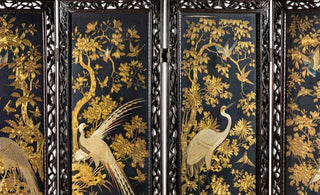
In the depths of time, a captivating tale unfolds—a tale woven into the very fabric of classical oriental art. Chinese screen panels, with their exquisite beauty and profound symbolism, stand as silent witnesses to centuries of cultural heritage and artistic mastery. The ancient story of Chinese screen panels is a captivating tale that intertwines art, culture, and history, reflecting the evolution of Chinese society through centuries. These screens, more than mere functional objects, are emblematic of the profound artistic and philosophical underpinnings of Chinese culture. In the realm of artistic expression, these elegant creations have long held a place of prominence, captivating the hearts and minds of collectors, artists, and enthusiasts alike. Join us on a journey through ancient China as we explore the captivating story of Chinese screen panels and the rich tapestry of history, artistry, and symbolism they embody.
Chinese Screen Panels as Window into the Past
Chinese screen panels, also known as folding screens, have a storied history that stretches back thousands of years. Their origins can be traced to the ancient Chinese courts, where they were used to divide spaces, create privacy, and serve as majestic backdrops for important ceremonies and events. These screens were not merely functional objects; they were works of art, imbued with cultural significance and artistic vision. The materials used in the construction of these screens were as diverse as the stories they told. Elaborate screens were crafted from precious materials such as intricately carved wood, gilded lacquer, delicate porcelain, or even shimmering silk. Each material brought its own unique texture, color, and visual impact, contributing to the overall aesthetic appeal of the screen. Chinese screen panels served as canvases for artists to express their creativity and convey intricate narratives. Through the use of various artistic techniques, such as painting, calligraphy, and relief carving, these screens became windows into worlds both real and imagined. One popular theme depicted on Chinese screen panels was landscape painting. These artworks transported viewers to serene mountain ranges, tranquil rivers, and lush gardens, inviting contemplation and a sense of harmony with nature. Artists skillfully employed techniques such as "shan shui" (mountain and water) painting to evoke a sense of awe and wonder, immersing the viewer in a serene and mystical realm. Another prevalent theme found on Chinese screen panels was the depiction of historical events and mythological stories. These narratives were often depicted through intricate and detailed scenes, capturing pivotal moments in Chinese history or bringing to life the heroic deeds of legendary figures from mythology. Each brushstroke and carved detail conveyed a sense of drama and emotion, engaging the viewer in a captivating visual narrative.
Symbolism and Allegory of Chinese Screen Panels
Beyond their aesthetic appeal, Chinese screen panels were laden with symbolism and allegory. The choice of motifs, colors, and arrangements held deep cultural and philosophical meanings, inviting viewers to delve into the hidden layers of interpretation. One common motif found on Chinese screens is the depiction of the Four Gentlemen, a group of plants symbolizing the virtues of the Confucian scholar. The plum blossom represents resilience in the face of adversity, the orchid symbolizes elegance and refinement, the bamboo embodies strength and flexibility, while the chrysanthemum signifies longevity and endurance. These plants, often depicted together, served as reminders of the noble qualities one should strive to cultivate. Dragons, another prevalent motif, represented imperial power, strength, and good fortune. These mythical creatures, with their sinuous bodies and fierce expressions, were often depicted amidst swirling clouds, symbolizing the emperor's divine authority and the harmonious balance between heaven and earth.Beyond their beauty and craftsmanship, Chinese screens also held significant symbolic meaning. The imagery depicted on the screens was carefully chosen to convey certain messages or bring good luck and fortune. Scenes of mountains and water represented stability and continuity, while peonies and lotus flowers symbolized prosperity and purity. In addition to their decorative purpose, screens were used to create private spaces within large rooms and were an essential element in the traditional Chinese architectural layout.
Chinese Screen Panels:A Timeless Legacy
Today, Chinese screen panels continue to captivate and inspire art lovers around the world. Their timeless beauty and cultural significance make them highly sought-after pieces for collectors, while artists and enthusiasts find in them a wellspring of inspiration and a connection to a rich artistic heritage. The intricate craftsmanship, attention to detail, and profound symbolism of Chinese screen panels have made them enduring symbols of classical oriental art. Their ability to transport viewers to distant landscapes, evoke deep emotions, and convey narratives that transcend time and place is a testament to the enduring power of art as a universal language. In the unfolding tale of Chinese screen panels, we discover a world teeming with artistic mastery, cultural heritage, and profound symbolism. Each brushstroke, each carved detail, and each carefully chosen motif tell a story that transcends time, inviting us to explore the rich tapestry of Chinese history and artistic expression.
In conclusion, the story of Chinese screen panels is a vivid illustration of the country’s artistic evolution, blending functionality with aesthetic brilliance. In the modern era, Chinese screen panels continue to be revered for their historical and artistic value. They have influenced interior design and art globally, with antique screens being highly sought after by collectors. Contemporary artists and designers often draw inspiration from these traditional screens, creating modern interpretations that honor their rich heritage. These screens are not just artifacts; they are a window into the soul of ancient China, showcasing the creativity, skill, and philosophical depth of its people. They remain a timeless testimony to the enduring legacy of Chinese art and culture.























